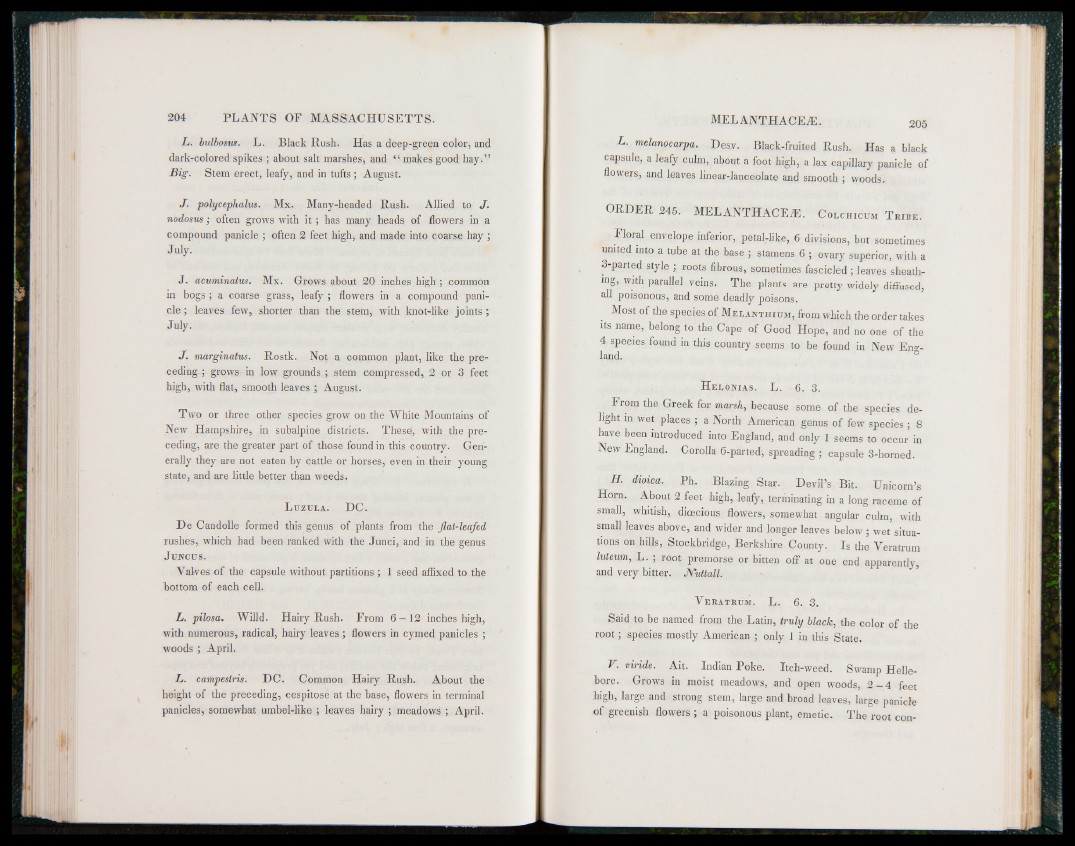
L. bulbosns. L. Black Rush. Has a deep-green color, and
dark-colored spikes ; about salt marshes, and “ makes good hay.”
Big- Stem erect, leafy, and in tufts ; August.
J. polycephalus. Mx. Many-headed Rush. Allied to J.
nodosus; often grows with i t ; has many heads of flowers in a
compound panicle ; often 2 feet high, and made into coarse hay ;
July.
J. acuminatus. Mx. Grows about 20 inches high; common
in bogs ; a coarse grass, leafy ; flowers in a compound panicle
; leaves few, shorter than the stem, with knot-like joints ;
July.
J. marginatus. Rostk. Not a common plant, like the preceding;
grows in low grounds ; stem compressed, 2 or 3 feet
high, with flat, smooth leaves ; August.
Two or three other species grow on the White Mountains of
New Hampshire, in subalpine districts. These', with the preceding,
are the greater part of those found in this country. Generally
they are not eaten by cattle or horses, even in their young
state, and are little better than weeds.
L uzula. DC.
De Candolle formed this genus of plants from the flat-leafed
rushes, which had been ranked with the Junci, and in the genus
J UNCUS.
Valves of the capsule without partitions ; 1 seed affixed to the
bottom of each cell.
L. pilosa. Willd. Hairy Rush. From 6 — 12 inches high,
with numerous, radical, hairy leaves ; flowers in cymed panicles ;
woods ; April.
L. campeslris. DC. Common Hairy Rush. About the
height of the preceding, cespitose at the base, flowers in terminal
panicles, somewhat umbel-like ; leaves hairy ; meadows ; April.
L. melanocarpa. Desy. Black-fruited Rush. Has a black
capsule, a leafy culm, about a foot high, a lax capillary panicle of
flowers, and leaves linear-lanceolate and smooth ; woods.
ORDER 245. MELANTHACEiE. C olchicum T r ib e .
Floral envelope inferior, petal-like, 6 divisions, but sometimes
united into a tube at the base ; stamens 6 ; ovary superior, with a
3-parted style ; roots fibrous, sometimes fascicled ; leaves sheathing,
with parallel veins. The plants are pretty widely diffused,
all poisonous, and some deadly poisons.
Most of the species of Melanthium, from which the order takes
its name, belong to the Cape of Good Hope, and no one of the
4 species found in this country seems to be found in New England.
H e LONIAS. L. 6. 3.
From the Greek for marsh, because some of the species delight
in wet places ; a North American genus of few species; 8
have been introduced into England, and only 1 seems to occur in
New England. Corolla 6-parted, spreading ; capsule 3-horned.
H. dioica. Ph. Blazing Star. Devil’s Bit. Unicorn’s
Horn. About 2 feet high, leafy, terminating in a long raceme of
small, whitish, dioecious flowers, somewhat angular culm, with
small leaves above, and wider and longer leaves below ; wet situations
on hills, Stockbridge, Berkshire County. Is the Veratrum
luteum, L. ; root premorse or bitten off at one end apparently,
and very bitter. Nuttall.
V eratrum. L. 6. 3.
Said to be named from the Latin, truly black, the color of the
ro o t; species mostly American ; only 1 in this State.
V. viride. Ait. Indian Poke. Itch-weed. Swamp Hellebore.
Grows in moist meadows, and open woods, 2 - 4 feet
high, large and strong stem, large and broad leaves, large panicle
of greenish flowers ; a poisonous plant, emetic. The root con